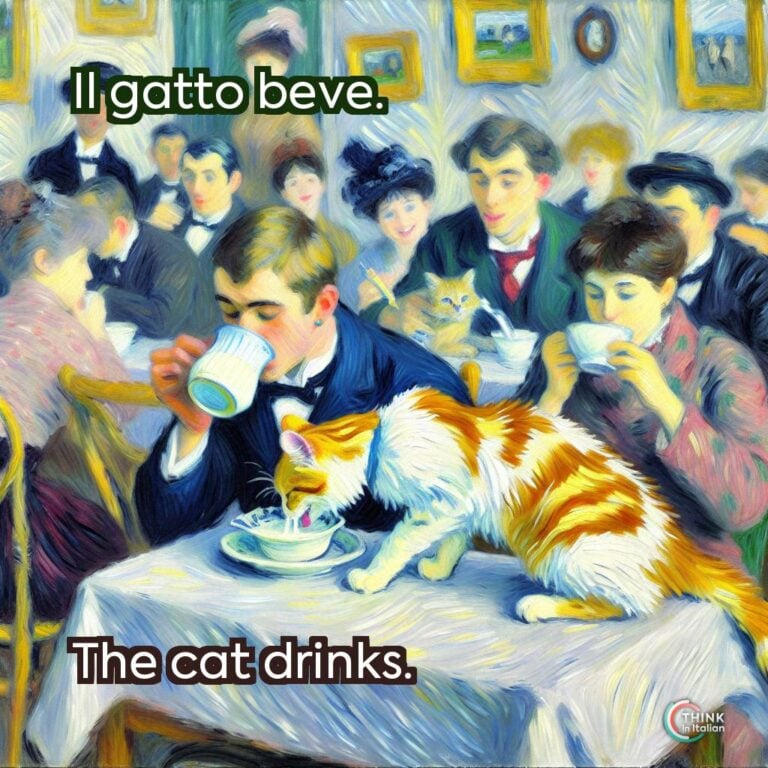Italian Auxiliary Verbs
In linguistics, an auxiliary verb is a verb that adds functional or grammatical meaning to the clause in which it appears. It is also commonly called “helping verb” because it accompanies the main verb to help form various tenses and moods of the main verb.
The most common English auxiliary verbs are “to be”, “to have”, and “to do”, used to create forms like progressive tenses (is running), perfect tenses (has eaten), and negative or interrogative forms (do not go).
Italian auxiliary verbs are essere(to be) and avere(to have), and are used to create all Italian compound verbs.
They are not classified among the standard three conjugations, but they are said to belong to coniugazione propria, literally translatable with “their own’s conjugation”, showcasing their unique behavior.
In both English and Italian – as well as many other languages – modal verbs behave as auxiliaries, indicating a modality such as possibility, necessity, obligation, likelihood… Italian modal verbs are dovere, potere, sapere, and volere, but I will not discuss them in this article.
Here, I will focus on Italian auxiliaries essere and avere, a fundamental part of the Italian syntax, required for proper sentence structure and for expressing detailed meanings and nuances in communication.
When to use “Essere” vs “Avere”
Essere
In Italian, the verb essere (to be) is used in several contexts and functions. Here I will list the primary cases when essere is employed:
- Identity and existence: used to express identity, characteristics, or the existence of someone or something.
Io sono Martina.
I am Martina.
Lei è un’insegnante.
She is a teacher.
- Location: to indicate the location of someone or something.
Siamo al parco.
We are at the park.
La scuola è qui.
The school is here.
- Conditions and states: to describe temporary or permanent states or conditions.
Sono stanco.
I am tired.
È felice.
He/She is happy.
- Auxiliary in compound tenses: used as an auxiliary verb in compound tenses, especially with intransitive verbs that take a indirect object and, therefore, require a preposition to link verb and object. These intransitive verbs usually indicate motion or a change of state.
Sono andato in Italia.
I went to Italy.
È cresciuta molto.
She has grown a lot.
Make sure you read the entire article to get to learn more about this topic in the last section!
- Passive voice: used to form the passive voice, indicating that the subject of the sentence is the recipient of an action.
Il libro è stato scritto da Giorgio.
The book was written by Giorgio.
La pizza è stata mangiata.
The pizza has been eaten.
- Impersonal constructions: used in impersonal constructions to express general ideas or weather conditions.
È importante studiare.
It is important to study.
È nevicato tutto il giorno.
It snowed all day.
Avere
Let me now show you the key situations in which avere is used:
- Possession: commonly used to indicate possession or ownership.
Ho una macchina nuova.
I have a new car.
Abbiamo due gatti.
We have two cats.
- Age: unlike English, it is used to express age.
Ho trent’anni.
I am thirty years old.
Quanti anni hai?
How old are you?
- Physical sensations: to describe physical feelings or needs.
Ho fame.
I am hungry.
Ho freddo.
I am cold.
- Auxiliary in compound tenses: is used as an auxiliary verb with transitive verbs in compound tenses, that is, verbs that select a direct object which requires no preposition to be introduced.
Ho visto Maria ieri.
I saw Maria yesterday.
Abbiamo mangiato la pizza.
We ate the pizza.
In the context of auxiliary choice, there are plenty of rules that should be considered. If you are passionate about linguistics as I am, you can dive deeper into the explanations about unergative verbs and unaccusative verbs.
Meanwhile, I will dedicate a short paragraph at the end of this article with a brief overview.
- Descriptive conditions: when describing certain conditions or states that are considered properties rather than inherent states.
Ha gli occhi blu.
He has blue eyes.
Ha un grande carisma.
He has a big charm.
- Obligations (in some contexts): although less common than the modal verb dovere, avere can be used to express need or obligation.
Ho da fare.
I have things to do.
“Essere” vs “Avere”: Passato Prossimo
One of the hardest parts of the Italian passato prossimo regards the choice of the auxiliary verbs essere andavere. Passato prossimo is a compound tense that is equivalent to the English present perfect tense, used to describe actions that happened in the recent past.
As I already mentioned before, we use one or the other depending on whether the main verb is transitive or intransitive:
Avere is used with transitive verbs, that is, verbs that are linked to the direct object without the use of any preposition. The few intransitive verbs it is used with, do not imply movement or change of state.
- Transitive verbs: such as mangiare (to eat), vedere (to see), sapere (to know).
Ho mangiato una pizza.
I ate a pizza.
- Intransitive verbs: they do not suggest movement or change, such as dormire (to sleep) or lavorare (to work).
Ho dormito otto ore.
I slept eight hours.
Essere is used with intransitive verbs, that is, verbs that need a preposition to be linked to the indirect object. Intransitive verbs generally describe movement or change of state, or they are reflexive verbs. Have a look at the sentences below:
- Verbs of movement: Such as andare (to go), venire (to come), arrivare (to arrive), partire (to leave).
Sono andato in Italia l’anno scorso.
I went to Italy last year.
- Change of state: like crescere (to grow), nascere (to be born), morire (to die).
Sei cresciuto molto dall’anno scorso!
You grew up a lot from last year!
- Reflexive verbs: always use essere.
Mi sono lavato.
I washed myself.
An important aspect of the auxiliary essere in compound verbs is that the past participle must agree in gender and number with the subject as in the sentences:
Lei è tornata ieri.
She returned yesterday.
I ragazzi sono usciti.
The boys went out.
“Essere” vs “Avere”: Conjugations
Conjugating essere and avere correctly is essential for proper communication in Italian, as these verbs are not only used frequently on their own but also serve as auxiliary verbs in various compound tenses.
Here I will show you how each verb is conjugated in the presente, imperfetto, and futuro semplice, so that you can conjugate the main compound tenses:
| Essere (to be) | Avere (to have) |
|---|---|
| Present Tense | Present Tense |
| Io sono | Io ho |
| Tu sei | Tu hai |
| Lui/Lei è | Lui/Lei ha |
| Noi siamo | Noi abbiamo |
| Voi siete | Voi avete |
| Loro sono | Loro hanno |
| Imperfetto | Imperfetto |
| Io ero | Io avevo |
| Tu eri | Tu avevi |
| Lui/Lei era | Lui/Lei aveva |
| Noi eravamo | Noi avevamo |
| Voi eravate | Voi avevate |
| Loro erano | Loro avevano |
| Futuro Semplice | Futuro Semplice |
| Io sarò | Io avrò |
| Tu sarai | Tu avrai |
| Lui/Lei sarà | Lui/Lei avrà |
| Noi saremo | Noi avremo |
| Voi sarete | Voi avrete |
| Loro saranno | Loro avranno |
“Fare” vs “Avere”
Fare
Fare is one of the most frequently used verbs in Italian, which can be translated with the English “to do” or “to make”. It appears in countless everyday phrases, idioms, and expressions, making it indispensable for any Italian learner.
- Doing an action:
Fare i compiti.
To do homework.
Fare la spesa.
To do the grocery shopping.
Fare la fila.
To stand in the line.
- Making something:
Fare una torta.
To make a cake.
Fare il pranzo/la cena.
To cook lunch/dinner.
- Idiomatic expressions:
Fare attenzione.
To pay attention.
Fare una passeggiata.
To take a walk.
Avere
Avere translates to “to have” in English, and is another core verb in the Italian language. As we saw already, it is critical for expressing possession, age, various states of being as well as feelings or needs, such as in:
Ho fame.
I am hungry.
Ho freddo.
I am cold.
The main linguistic situation where the use of these two verbs might overlap is in expressions describing conditions or states, such as fare caldo/freddo and avere caldo/freddo.
On the one hand, avere caldo/freddo describes personal sensations of heat or cold, on the other hand fare caldo/freddo is used to describe the general weather condition or the environment.
This distinction is important to understand the nuanced use of these verbs in Italian, where avere focuses on personal sensation and fare on creating or describing conditions or actions, even in seemingly overlapping contexts.
“Essere” vs “Avere” as Auxiliary Verbs
Most intransitive verbs in Italian take essere as their auxiliary because they describe actions where the subject is either moving from one place to another or changing in some way.
Think of it like this: if the verb tells us that something or someone ends up in a different place or becomes different (such as arriving, leaving, growing, or transforming), then essere is used.
For example:
- Andare (to go) takes essere because the person is moving from one place to another.
- Diventare (to become) takes essere because the person or thing is changing into something different.
These verbs focus on the state or condition of the subject changing, rather than just the action they are doing.
In linguistics they are called unaccusative intransitive verbs, meaning that the subject is experiencing or undergoing a change, rather than actively doing something.
Instead, verbs like camminare (to walk), sciare (to ski), and correre (to run) take avere as their auxiliary because they focus on the action itself, rather than on the subject moving to a different place or changing in some way.
These verbs describe activities that the subject is actively doing but there’s no emphasis on arriving somewhere or becoming something different.
For example:
Ho camminato per due ore.
I walked for two hours.
The focus is on the act of walking, not on where you end up.
Ho corso nel parco.
I ran in the park.
It’s about the running, not reaching a destination.
In linguistics, they are called unergative intransitive verbs. Unlike verbs that use essere, the subject here is performing an action without necessarily undergoing any change or reaching a different state.
Therefore, avere is used to emphasize the activity the subject is doing, without implying that they end up somewhere different as a result.
Embrace the Complexity
In my experience of language teacher, I’ve seen learners struggle with essere and avere. My advice? Embrace these complexities.
Understanding them enriches not only your grasp of the Italian language, but also your knowledge of the Italian culture.
Essere and avere are more than grammar; they’re a journey through language and thought, which teaches you more about how Italians think and express themselves.
Yes, it’s a challenge, but it’s also a doorway to truly mastering Italian. So, get ready, and improve your Italian language skills.






